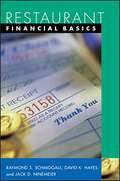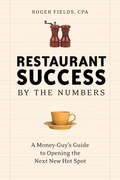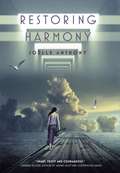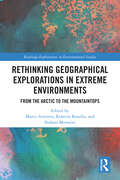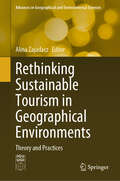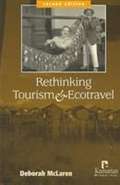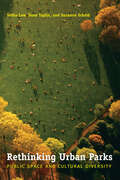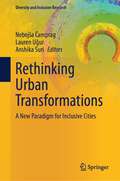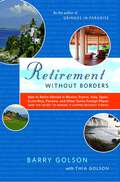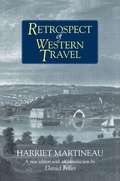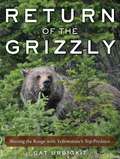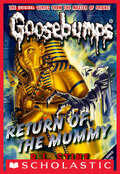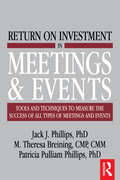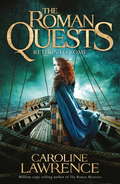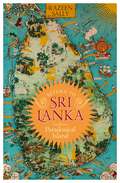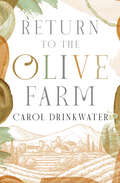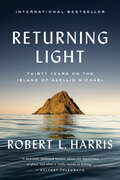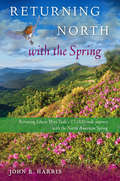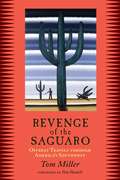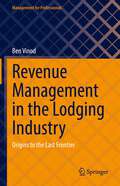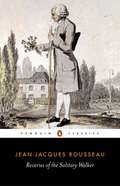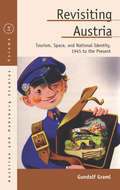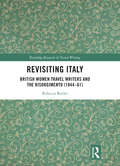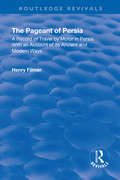- Table View
- List View
Restaurant Financial Basics
by Raymond S. Schmidgall David K. Hayes Jack D. NinemeierOne of the keys to a successful restaurant business is strong financial management. This volume in the Wiley Restaurant Basics Series provides restaurateurs with the tools necessary to manage their food-based operation by explaining basic accounting principles such as pricing, budgeting, cost control, payroll, and cash flow.
Restaurant Success by the Numbers
by Roger FieldsNinety percent of all restaurants fail, and those that succeed happened upon that mysterious X factor, right? Wrong! A man of many hats-money-guy, restaurant owner, and restaurant consultant-Roger Fields shows how a restaurant can survive its first year, based on far more than luck, and keep diners coming back for many years to come. Featuring real-life restaurant start-up stories (including some of the author'¬?s own), this comprehensive how-to walks readers through the logistics of opening a restaurant: creating the concept, choosing a location, designing the menu, establishing ambiance, hiring staff, and, most important, turning a profit. Opening a restaurant isn'¬?t easy, but this realistic dreamer'¬?s guide helps set the table for lasting success.From the Trade Paperback edition.
Restoring Harmony
by Joëlle AnthonyThe year is 2041, and sixteen-year-old Molly McClure has lived a relatively quiet life on an isolated farming island in Canada, but when her family fears the worst may have happened to her grandparents in the US, Molly must brave the dangerous, chaotic world left after global economic collapse one of massive oil shortages, rampant crime, and abandoned cities. Molly is relieved to find her grandparents alive in their Portland suburb, but they're financially ruined and practically starving. What should've been a quick trip turns into a full-fledged rescue mission. And when Molly witnesses something the local crime bosses wishes she hadn't, Molly's only way home may be to beat them at their own game. Luckily, there's a handsome stranger who's willing to help. Restoring Harmony is a riveting, fast-paced dystopian tale complete with adventure and romance that readers will devour.
Rethinking Geographical Explorations in Extreme Environments: From the Arctic to the Mountaintops (Routledge Explorations in Environmental Studies)
by Marco Armiero Roberta Biasillo Stefano MorosiniFocusing on extreme environments, from Umberto Nobile’s expedition to the Arctic to the commercialization of Mt Everest, this volume examines global environmental margins, how they are conceived and how perceptions have changed. Mountaintops and Arctic environments are the settings of social encounters, political strategies, individual enterprises, geopolitical tensions, decolonial practises, and scientific experiments. Concentrating on mountaineering and Arctic exploration between 1880 – 1960, contributors to this volume show how environmental marginalisation has been discursively implemented and materially generated by foreign and local actors. It examines to what extent the status and identity of extreme environments has changed during modern times, moving them from periphery to the centre and discarding their marginality. The first section looks at ways in which societies have framed remoteness, through the lens of commercialization, colonialism, knowledge production and sport, while the second examines the reverse transfer, focusing on how extreme nature has influenced societies, through international network creation, political consensus and identity building. This collection enriches the historical understanding of exploration by adopting a critical approach and offering multidimensional and multi-gaze reconstructions. This book is essential reading for students and scholars interested in environmental history, geography, colonial studies and the environmental humanities.
Rethinking Sustainable Tourism in Geographical Environments: Theory and Practices (Advances in Geographical and Environmental Sciences)
by Alina ZajadaczThis book covers the current escalation of social problems related to the unstable political situation, economic crisis, as well as growing problems related to the state of the natural environment (existential climate crisis; pollution of land, oceans, and the atmosphere; severe declines in biodiversity) which requires a new rethinking of the sustainable tourism paradigm, in relation to the realities of the modern world, based on the practices observed in the tourist services sector. „Tourism is like fire, you can cook food on it, you can also burn down your house”—says the proverb. On the one hand, it allows for the regeneration of physical and mental strength of visitors, as well as provides funds for the economic development of the destination, but on the other hand, it contributes to a lot of damage to the geographical environment. The period of "stopping" of tourism during the lockdown caused by the COVID-19 pandemic allowed many areas to be relieved of the tourist traffic, which resulted in the observed revitalization of the natural environment, but also huge social and economic problems in destinations that are largely dependent on income from tourism. The rapid resurgence of tourism after the pandemic restored revenues but also caused many social tensions. The problem of overtourism returned, and residents protested, calling for "tourists to go home." The entire tourism system requires a thorough analysis of the complex consequences of its development. This book presents many challenges facing contemporary tourism. Its theoretical and practical aspects provide a useful knowledge base for both researchers studying changes in tourism and practitioners in the tourism services sector. The content also serves as an inspiration to search for optimal solutions aimed at the sustainable development of contemporary and future tourism.
Rethinking Tourism and Ecotravel
by Deborah McLarenA fully revised and comprehensive overview of the history and global development of tourism, often considered the largest industry in the world. Despite promising great benefits to hosts and guests alike, tourism has often resulted in some very stark and painful consequences for local host communities and the environment.
Rethinking Urban Parks: Public Space and Cultural Diversity
by Setha LowUrban parks such as New York City's Central Park provide vital public spaces where city dwellers of all races and classes can mingle safely while enjoying a variety of recreations. By coming together in these relaxed settings, different groups become comfortable with each other, thereby strengthening their communities and the democratic fabric of society. But just the opposite happens when, by design or in ignorance, parks are made inhospitable to certain groups of people. This pathfinding book argues that cultural diversity should be a key goal in designing and maintaining urban parks. Using case studies of New York City's Prospect Park, Orchard Beach in Pelham Bay Park, and Jacob Riis Park in the Gateway National Recreation Area, as well as New York's Ellis Island Bridge Proposal and Philadelphia's Independence National Historical Park, the authors identify specific ways to promote, maintain, and manage cultural diversity in urban parks. They also uncover the factors that can limit park use, including historical interpretive materials that ignore the contributions of different ethnic groups, high entrance or access fees, park usage rules that restrict ethnic activities, and park “restorations” that focus only on historical or aesthetic values. With the wealth of data in this book, urban planners, park professionals, and all concerned citizens will have the tools to create and maintain public parks that serve the needs and interests of all the public.
Rethinking Urban Transformations: A New Paradigm for Inclusive Cities (Diversity and Inclusion Research)
by Nebojša Čamprag Lauren Uğur Anshika SuriThis edited volume delves into the intricate challenges that cities face in the midst of evolving socio-political, economic, and environmental landscapes. With a focus on inclusivity and diversity, the book thoroughly examines the transformation of urban systems and their manifestations within broader spatial contexts. Employing a trans- and interdisciplinary approach, the editors have strategically curated diverse research clusters to address key aspects of inclusive urban transformation from multiple perspectives. These clusters explore alternative paradigms for sustainable urban transformation, the dynamics of city regions, inclusive tourism development, the de-contestation of urban heritage to diversify urban identities, and inclusive intersectional city-making practices. By fostering collaboration and cross-pollination among these clusters, the volume fosters a transdisciplinary understanding of inclusive and sustainable urban transformation, facilitating the development of more holistic approaches in conceptualizing and promoting inclusive urban theory and praxis.
Retirement Without Borders: How to Retire Abroad in Mexico, France, Italy, Spain, Costa Rica, Panama, and Other Sunny, Foreign Places (and the Secret to Making It Happen without Stress)
by Barry Golson Thia GolsonBarry Golson knows all about retiring abroad -- he and his wife, Thia, have lived in six different countries. Now they choose expatriate-friendly locales around the world for their low cost and their high quality of living and explain how to investigate and settle in each country with minimum hassle and maximum pleasure. Taking you step-by-step through the process of researching, testing, and finally living abroad, the Golsons' practical how-to guide covers all the major issues, including health care, finances, real estate, taxes, and immigration. Each location is profiled by an expatriate writer who has made that country his or her home and who knows how to answer all the questions about living richly and economically in some of the world's most beautiful places.
Retrospect of Western Travel
by Harriet Martineau"This new abridgement of the original 1838 edition offers a view of Jacksonian America. Here are Martineau's condemnation of slavery and her championship of abolition and women's rights; her incisive portraits of Jackson, Clay, Calhoun, Webster, Garrison, Emerson, and the Beechers; her observations of American schools, asylums, colleges, and prisons; and her eyewitness accounts of a presidential assassination attempt, a lynch mob, a slave auction, a Quaker wedding, and a Harvard commencement. Historian Daniel Feller, author of The Jacksonian Promise, introduces the narrative, identifies the major characters, and provides an index for easy use. "--BOOK JACKET. Title Summary field provided by Blackwell North America, Inc. All Rights Reserved
Return of the Grizzly: Sharing the Range with Yellowstone's Top Predator
by Cat UrbigkitConflicts arise when humans and grizzlies are forced into close quarters.The Yellowstone grizzly population has grown from an estimated 136 bears when first granted federal protection as a threatened species to as many as 1,000 grizzlies in a tri-state region today. No longer limited to remote wilderness areas, grizzlies now roam throughout the region—in state parks, school playgrounds, residential subdivisions, on farms and ranches, and in towns and cities throughout the region. Return of the Grizzly tells the story of the successful effort to recover this large carnivore, the policy changes and disputes between bear managers and bear advocates, and for the first time, provides insight to what recovery means for the people who now live with grizzlies across a broad landscape. From cowboys on horseback chased by a charging grizzly, and grizzlies claiming game animals downed by human hunters, to the numerous self-defense killing of grizzlies that occur each year, the manuscript examines increases in conflicts and human fatalities caused by grizzlies in this ecosystem inhabited by humans who live there year-round. Human–bear interactions, grizzly attacks and deaths, avoiding attacks, effects on agriculture, wildlife protesters, the consequences of bear habituation, and more are all covered.
Return of the Mummy (Classic Goosebumps #18)
by R.L. StineGet wrapped up in an undead adventure in this–bestselling classic from the Master of Fright—now with “Behind the Screams” bonus material.After last year’s scary adventure, Gabe’s a little nervous about being back in Egypt. Back near the ancient pyramids. Back where he saw all those creepy mummies. Then he learns about an Egyptian superstition. A secret chant that is supposed to bring mummies back to life. Gabe’s uncle says it’s just a hoax. But now it sounds like something’s moving in the mummy’s tomb. No way a couple of dumb words can wake the dead. Can they?
Return on Investment in Meetings and Events
by Jack J. Phillips M. Theresa BreiningThe Phillips ROI Methodology™ utilizes five levels of evaluation, which are essential in determining the return on investment.At Level 1 - Reaction and Planned Action, attendee and stakeholder satisfaction from the meeting can be measured. Almost all organizations evaluate at Level 1, usually with a generic, end-of-meeting questionnaire. While this level of evaluation is important as a “stakeholder” satisfaction measure, a favorable reaction does not ensure that attendees have acquired new skills, knowledge, opinions or attitudes from the meeting. At Level 2 - Learning, measurements focus on what participants learned during the meeting using tests, skill practices, role-plays, simulations, group evaluations, and other assessment tools. A learning check is helpful to ensure that attendees have absorbed the meeting material or messages and know how to use or apply it properly. It is also important at this level to determine the quantity and quality of new professional contacts acquired and whether existing professional contacts were strengthened due to the meeting. However, a positive measure at this level is no guarantee that what was learned or whether the professional contacts acquired will be used on the job. At Level 3 - Job Applications, a variety of follow-up methods can be used to determine if attendees applied on the job what they learned or acquired at the meeting. The frequency and use of skills are important measures at Level 3. While Level 3 evaluations are important to gauge the success of the meeting, it still does not guarantee that there will be a positive business impact in the organization or for the attendee. At Level 4 - Business Results, the measurement focuses on the actual business results achieved by meeting participants as they successfully apply the meeting material or messages. Typical Level 4 measures include output, sales, quality, costs, time and customer satisfaction. Although the meeting may produce a measurable business impact, there is still a concern that the meeting may cost too much. At Level 5 - Return on Investment, this ultimate level of measurement compares the monetary benefits from the meeting with the fully-loaded meeting costs as expressed in the ROI formula. All levels of evaluation must be conducted in order to determine the ROI of a meeting or event. The data collected should show a chain of impact occurring through the levels as the skills and knowledge learned (Level 2) are applied on the job (Level 3) to produce business results (Level 4).
Return to Rome: Book 4 (The Roman Quests #4)
by Caroline LawrenceThe fourth and final book in the new historical adventure series from million copy selling Caroline Lawrence, set in Roman Britain during the reign of the evil Emperor Domitian.AD 96. Bouda, an orphaned British girl with a troubled past, has been helping Juba and his siblings since they first arrived in Britannia. For almost two years they have been in hiding from the Emperor Domitian's agents. But now information has come to light that could bring down the tyrant. When Juba and his sister decide to return to Rome with the man who has this evidence, Bouda goes with them. But is it ever right to kill a tyrant?From the bestselling author of THE ROMAN MYSTERIES, perfect for children studying at Key Stage 2.
Return to Rome: Book 4 (The\roman Quests Ser. #4)
by Caroline LawrenceThe fourth and final book in the new historical adventure series from million copy selling Caroline Lawrence, set in Roman Britain during the reign of the evil Emperor Domitian.AD 96. Bouda, an orphaned British girl with a troubled past, has been helping Juba and his siblings since they first arrived in Britannia. For almost two years they have been in hiding from the Emperor Domitian's agents. But now information has come to light that could bring down the tyrant. When Juba and his sister decide to return to Rome with the man who has this evidence, Bouda goes with them. But is it ever right to kill a tyrant?From the bestselling author of THE ROMAN MYSTERIES, perfect for children studying at Key Stage 2.
Return to Sri Lanka
by Razeen SallyA blend of travel writing, memoir, history and current affairs that tells the story of Sri Lanka. A perfect read for first-time visitors, Sri Lankans abroad or at home, or anyone looking to deepen their understanding of one of the world&’s most fascinating and paradoxical countries. Razeen Sally was born to a Sri Lankan Muslim father and a Welsh mother. Just before his teens, a political conflict tore his family apart and he left Sri Lanka, barely going back for thirty years. When he finally returned &‘home&’, he spent much of the next decade crisscrossing the island, trying to understand this paradoxical place. Blessed with nature&’s bounty and an easy, pleasure-loving people, it was nevertheless scarred by ethnic conflict and the violence of civil war. As a native and a tourist, Sally makes an ideal guide to Sri Lanka&’s past and present. He won&’t tell you which restaurant has the best reviews or the price of a hotel room. Instead, he will accompany you like a learned friend, sharing his journeys, pointing out the unmissable gems beyond the obvious spots, and unpacking the nation&’s culture and history. Insightful, intimate and moving, Return to Sri Lanka is an indispensable book, whether you're already familiar with this spectacular country, or planning your first visit.
Return to the Olive Farm (The Olive Farm Series)
by Carol DrinkwaterAt a small farm in Provence, a woman tries to do her part to save the bees—and the planet—in this stirring, entertaining memoir. After a long research trip, Carol Drinkwater is back home with her husband, Michel, on their olive farm in the south of France. She&’s overjoyed, but also has something serious on her mind: the ecological threats to their own farm—and countless others. The die-off of honey bees has reached crisis levels globally, and Carol is concerned about the state of their hives. Some farmers and scientists believe urgent change is needed to address agricultural techniques that are destroying the planet. But when Carol joins their chorus, it may put their beloved farm in jeopardy. It&’s time for a true commitment—but running an organic farm, the couple soon discovers, is not as simple as it sounds . . .Praise for the Olive Farm series &“Vibrant, intoxicating and heartwarming.&” —Sunday Express &“Spellbinding . . . a must for anyone who dreams of moving to a kinder climate and starting a new life.&” —Choice
Returning Light: Thirty Years on the Island of Skellig Michael
by Robert L. HarrisThe Acclaimed International Bestseller "Reading Returning Light is a spiritual experience." —Irish ExaminerBy the lighthouse keeper on the remote, otherworldly Irish island of Skellig Michael, a "profound memoir about the importance of place and what it really means to belong" (Belfast Telegraph)“On Skellig Michael, thousands of birds appear and disappear, erecting towers, coming together in wings of movement which build and unravel over the empty sea. Often, no one else is there to stand beside me on the island. The mind wanders; links with the past are easily made; ancient ways of viewing things come alive.”In 1987, Robert Harris happened upon an unusual job posting in the local paper—a new warden service was being set up on the island of Skellig Michael, and the deadline was imminent. Just weeks later he was on his way to set up camp in one of Ireland’s most remote locations, unaware that he would be making that same journey every May for the next 30 years.Here he transports us to the otherworldly island, a place that is teeming with natural life, including curious puffins that like to visit his hut. From the precipice he has observed a coastline that is relatively unchanged for the last thousand years—a beacon of equilibrium in an ever-changing world.But the island can be fierce too. It’s inhabitable for only five months of the year, and solitude can quickly become isolation as bad weather rolls in to create a veil between Skellig Michael and the rest of the world, when the dizzying terrain can become a very real threat to life.A beautiful and evocative work of nature writing, Returning Light is an extraordinary memoir about the profound effect a place can have on us, and how a remote location can bring with it a great sense of belonging.
Returning North with the Spring
by John R HarrisAt winter's end in 1947, driven by the devastating loss of a son killed in World War II, naturalist Edwin Way Teale followed the dawning spring season northward in an amazing 17,000-mile odyssey from the Everglades to Maine. He wrote about the adventure in North with the Spring. Its sequel Wandering Through Winter won the Pulitzer Prize.Retracing Teale's route, writer John Harris reveals a vastly changed natural world. In Returning North with the Spring, he stops at the very places where Teale once stood, trekking through the Okefenokee wetland, the Great Smoky Mountains, the Great Dismal Swamp, the New Jersey Pine Barrens, and Cape Cod. He is stunned to see how climate change, invasive species, and other factors have affected the landscapes and wildlife. Yet he also discovers that many of the sites Teale described have been newly "rewilded" or permanently protected by the government.Homage to the past, report on the present, glimpse into the future--this book honors what has been lost in the years since Teale's famous journey and finds hope in the small tenacities of nature.
Revenge of the Saguaro
by Peter Hamill Tom MillerTom Miller's Southwest is a vortex of cockfights and cantinas, of black velvet paintings and tacky bolo ties, of eco-militants, border-crossers, and eccentric characters whose outlook is as spare and elemental as the desert that surrounds them. This is Miller's turf. With wit and insight, he reveals how the clichés of romanticism and capitalism have run amuck in his homeland. When a saguaro cactus outside Phoenix kills its own assassin, it becomes clear that no other guide to the Southwest manifests such a clear moral vision while reveling in the joy of this magnificent land and its people. Originally published by National Geographic as Jack Ruby's Kitchen Sink, it received the Gold Award for Best Travel Book in 2000 from the Society of American Travel Writers.Tom Miller has been writing about the American Southwest and Latin America for more than three decades. His ten books include The Panama Hat Trail, which follows the making and marketing of one Panama hat, and Trading with the Enemy, which Lonely Planet says "may be the best travel book about Cuba ever written." Miller began his journalism career in the underground press of the late '60s and early '70s, and has written articles for The New York Times, The Washington Post, The New Yorker, Smithsonian Magazine, Natural History, and Rolling Stone. He lives in Tucson, Arizona, with his wife, Regla.
Revenue Management in the Lodging Industry: Origins to the Last Frontier (Management for Professionals)
by Ben VinodThis book provides an end-to-end view of revenue management in the hospitality industry. The book highlights the origins of hotel reservations systems and revenue management, challenges unique to hotels, revenue management models, new generation retailing, and personalization and steps required to remain competitive in the marketplace. This book is intended for practitioners to understand the basics and have a comprehensive view of the impacts of revenue management on product distribution, reservations, inventory control, including the latest advances in the field of attribute-based room pricing and inventory control.There are several aspects of revenue management that are not covered in books and journal articles such as hotel pricing, hotel fully allocated costs, content parity, impact of Online Travel Agencies on hotels, competitive revenue management and attribute-based room pricing and inventory control which represents the last frontier in hotel revenue management with intelligent retailing. Leveraging emerging technologies, such as Artificial Intelligence and Blockchain and the future state of revenue management, are also addressed.
Reveries of the Solitary Walker
by Jean-Jacques RousseauAfter a period of forced exile and solitary wandering brought about by his radical views on religion and politics, Jean-Jacques Rousseau returned to Paris in 1770. Here, in the last two years of his life, he wrote his final work, the Reveries. In this eloquent masterpiece the great political thinker describes his sense of isolation from a society he felt had rejected his writings - and the manner in which he has come to terms with his alienation, as he walks around Paris, gazing at plants, day-dreaming and finding comfort in the virtues of solitude and the natural world. Meditative, amusing and lyrical, this is a fascinating exploration of Rousseau's thought as he looks back over his life, searching to justify his actions, to defend himself against his critics and to elaborate upon his philosophy.
Revisiting Austria: Tourism, Space, and National Identity, 1945 to the Present (Austrian and Habsburg Studies #28)
by Gundolf GramlFollowing the transformations and conflicts of the first half of the twentieth century, Austria’s emergence as an independent democracy heralded a new era of stability and prosperity for the nation. Among the new developments was mass tourism to the nation’s cities, spa towns, and wilderness areas, a phenomenon that would prove immensely influential on the development of a postwar identity. Revisiting Austria incorporates films, marketing materials, literature, and first-person accounts to explore the ways in which tourism has shaped both international and domestic perceptions of Austrian identity even as it has failed to confront the nation’s often violent and troubled history.
Revisiting Italy: British Women Travel Writers and the Risorgimento (1844–61) (Routledge Research in Travel Writing)
by Rebecca ButlerWith the rise of mass tourism, Italy became increasingly accessible to Victorian women travellers not only as a locus of artistic culture but also as a site of political enquiry. Despite being outwardly denied a political voice in Britain, many female tourists were conspicuous in their commitment to the Italian campaign for national independence, or Risorgimento (1815–61). Revisiting Italy brings several previously unexamined travel accounts by women to light during a decisive period in this political campaign. Revealing the wider currency of the Risorgimento in British literature, Butler situates once-popular but now-marginalized writers: Clotilda Stisted, Janet Robertson, Mary Pasqualino, Selina Bunbury, Margaret Dunbar and Frances Minto Elliot alongside more prominent figures: the Shelley-Byron circle, the Brownings, Florence Nightingale and the Kemble sisters. Going beyond the travel book, she analyses a variety of forms of travel writing including unpublished letters, privately printed accounts and periodical serials. Revisiting Italy focuses on the convergence of political advocacy, gender ideologies, national identity and literary authority in women’s travel writing. Whether promoting nationalism through a maternal lens, politicizing the pilgrimage motif or reviving gothic representations of a revolutionary Italy, it identifies shared touristic discourses as temporally contingent, shaped by commercial pressures and the volatile political climate at home and abroad.
Revival: A Record of Travel by Motor in Persia with an Account of its Ancient and Modern Ways (Routledge Revivals)
by Henry FilmerIt is the dawn of history and of the dispersion of the Indo-European peoples. They are breaking their tents in central Asia along the Hindu Kush and the Pamirs, primitive Aryans with their dogs and their herds of domesticated animals. In their trek they will proceed to the farthest confines of Europe. From them the peoples of England, France, Germany, Italy, Spain, Scandinavia, Russia, Greece and other will take their origin. A part will penetrate into India and another portion into Persia. They will build empires and munitions factories, cathedrals and cabarets. Some less simple-minded, the Kurds, Lurs and Bakhtiaris will maintain in Persia their primitive character into the twentieth century. With them in their dispersion, the Aryans carry the sacred fire which they have worshiped since they became acquainted with its use. It was man's first great step in the mastery of nature. The memory of its aid will be consecrated in one of the World's great religions; its flame will never be extinguised on the great Iranian plateau, the museums of religions.
